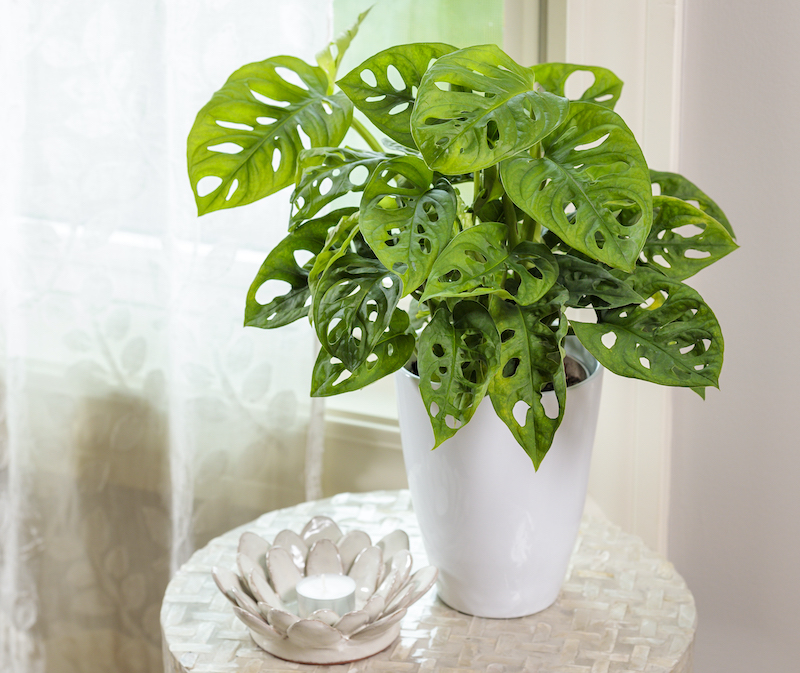Growing Monstera
Monsteras are tropical plants that conjure images of warm weather and sunny locations. The foliage is the part of the plant that stands out and ensures it is recognized. Leaves have splits or holes known as fenestrations that create a unique and memorable appearance. The leaf shape depends on the cultivar, and while most varieties have solid green foliage, some variegated types are available. Some Monstera plants are vining, and others have upright stems that grow in a tree-like shape. Monstera plants are easy to grow, making them excellent for beginners; they also introduce a lot of greenery and visual interest to a space.

Monstera Sunlight Requirements
Monstera plants prefer bright, indirect sunlight. A sunny window that receives at least 6 hours of sunlight per day is best. Rotate the plant every couple of weeks so that each side receives sunlight. Direct light may damage and burn the leaves, while limited amounts of light may cause the Monstera to become leggy.
Planting Monstera
Use rich, moist, but well-drained soil for Monstera plants. The soil can be acidic to neutral. These plants are fast growers, so they perform best in soil with high organic content or fertilizer to support growth. Monstera needs room to grow and this also includes their roots. Plants that are root bound, or have outgrown their pot, may not grow as fast and may experience stunted growth. Repot Monstera every two years or as needed and select a pot that is one to two inches large in diameter. Choose a container that has drainage, so excess water can drain.

Watering Monstera
Most Monsteras prefer damp soil but also like to dry out between waterings. In nature, Monstera plants grow as epiphytes, so they require moist, but well-drained soil. Feel the soil and water when the top several inches are dry. Monstera plants also appreciate increased humidity, so locate the plant in a naturally humid area for best results. Plants can be grown in areas with average humidity, but you may need to use a humidifier or a pebble tray with water to give the foliage the extra dampness it craves.
Fertilizing Monstera
All Monstera plants respond well to fertilizing, especially the large cultivars, like the Monstera deliciosa. Fertilizing plants provides a balanced diet, similar to what the plant would receive in nature. This boost in nutrition is especially beneficial for large leafy plants. Feed Monstera using balanced, water-soluble plant food. Time the fertilizer application to coincide with a routine watering session. Feed Monstera plants every 2 to 4 weeks during the spring and summer or when the plant is actively growing.
Common Monstera Problems
Monstera plants like increased humidity, and the leaves may dry out and turn brown, starting along the edges if the air is too dry. This can be fixed with a humidifier or humidity tray. Too much water may cause the foliage to turn yellow at the tips, and drooping or curled leaves are signs the plant is dehydrated. Keep an eye out for these indicators and adjust your care accordingly.
Some plant owners find the aerial roots of the Monstera deliciosa to be unsightly. These roots serve a purpose in nature but are not necessary for houseplants. Long aerial roots can be tucked into the pot or trimmed. Removing the aerial roots will not harm the plant.

Propagating Monstera
Propagating Monstera is easy. Sanitize shears and remove a section of stem that has leaves and growth nodes or aerial roots. The nodes look like small bumps on the stems, and climbing plants use them to latch onto a support or wall. Place the cut end and the growth nodes in water or moist potting soil. The growth points should transition to roots in a few weeks. Cuttings propagated in water can be moved to soil when the roots are at least an inch long.
Growing Monstera Outdoors
Relocate your Monstera outdoors during the warmer months to add bold greenery to your porch or deck. Place potted Monstera plants in partial shade because too much light can damage the lovely foliage. It is always best to plant Monstera in a container with drainage, but plants grown outside must have good drainage. Plants that are exposed to rain and even heavy dew need a way for excess water to drip away. Water potted Monstera plants when the top few inches of soil are dry. Monitor the foliage for signs of pests, and preemptively spray the plant with horticultural oil to ward off insects.
 |
Author Alison Cotsonas - Published 3-02-2023 |
